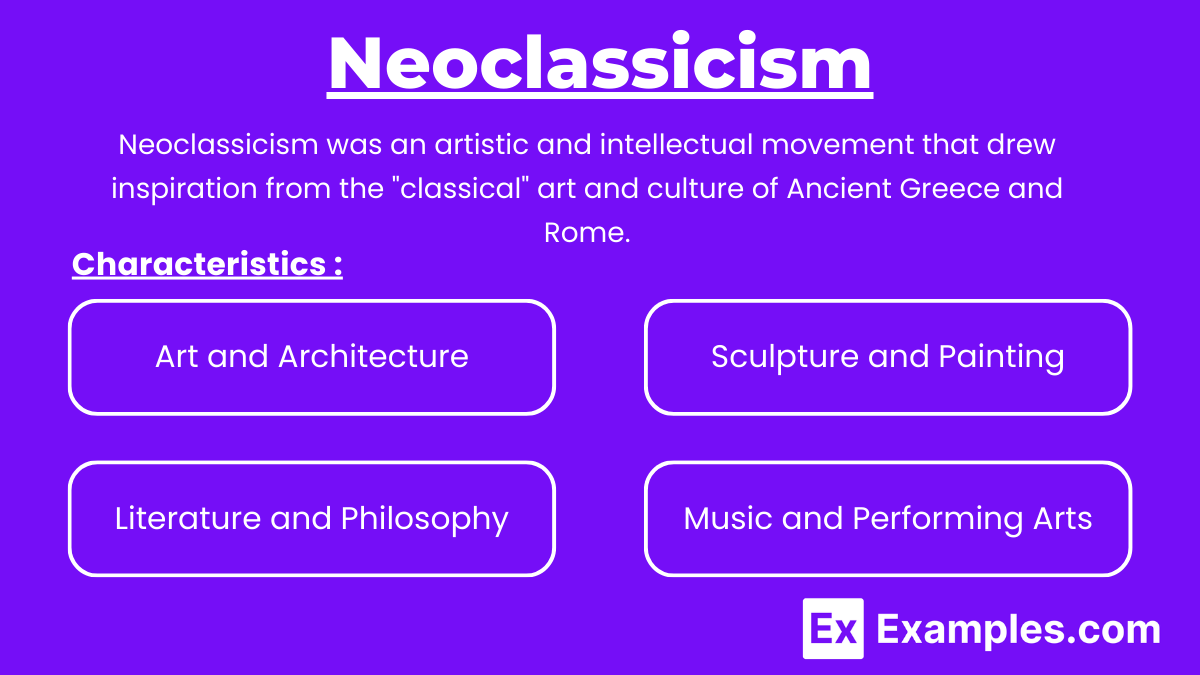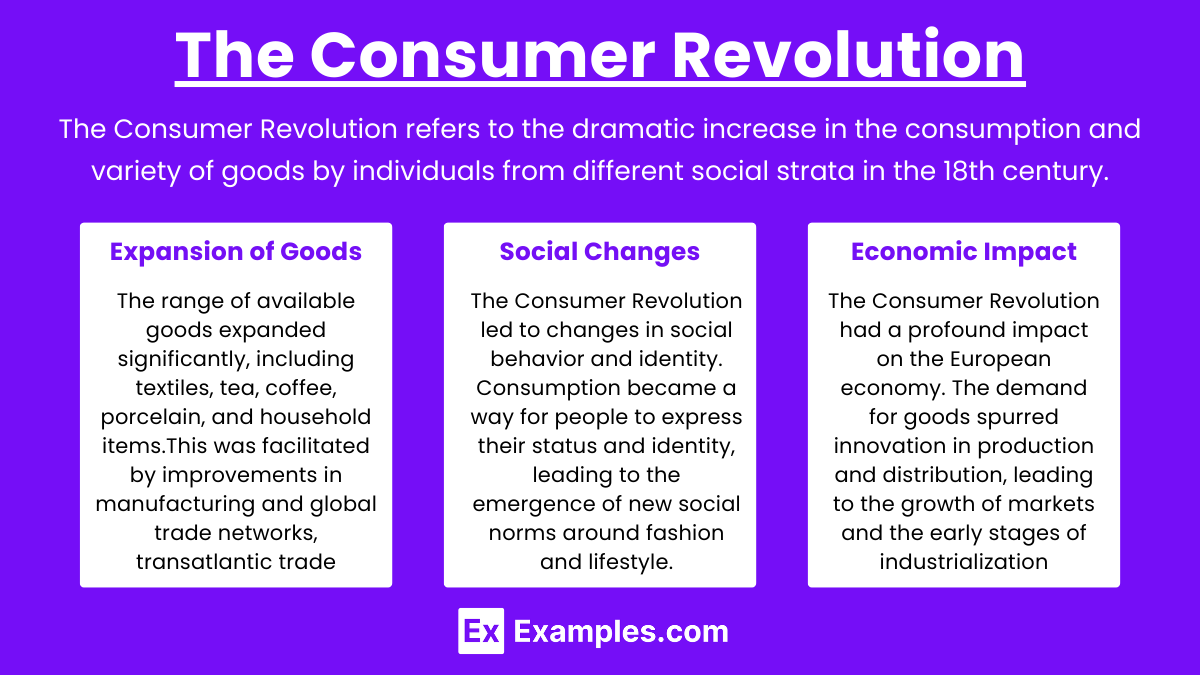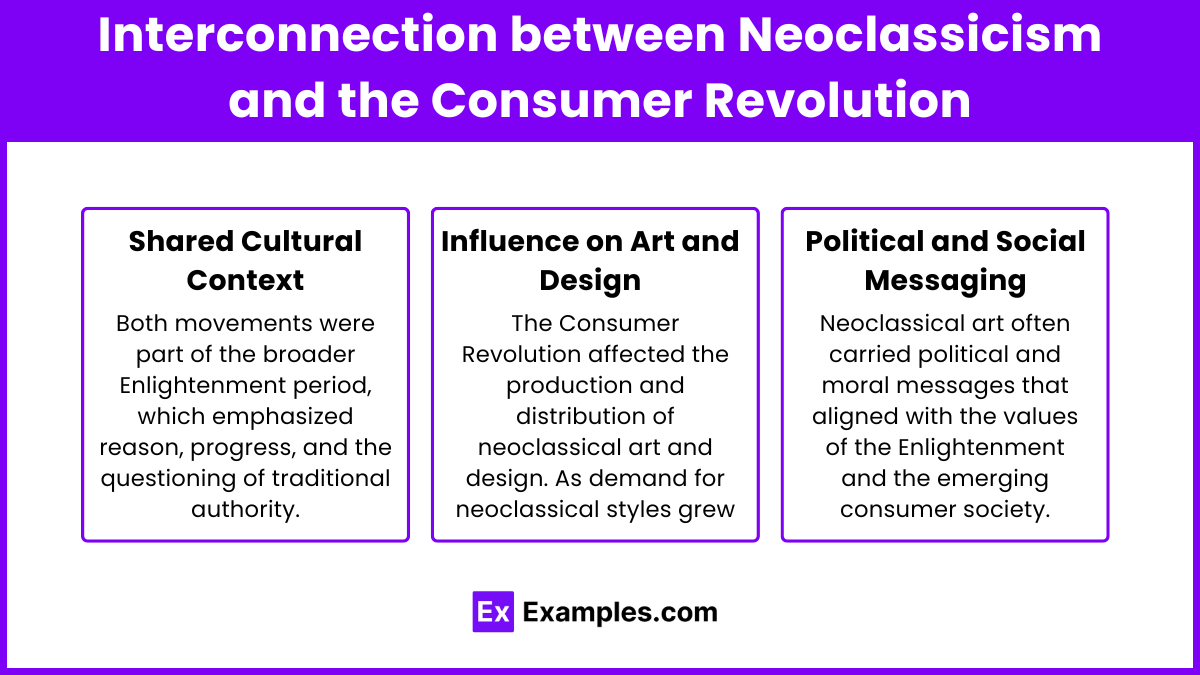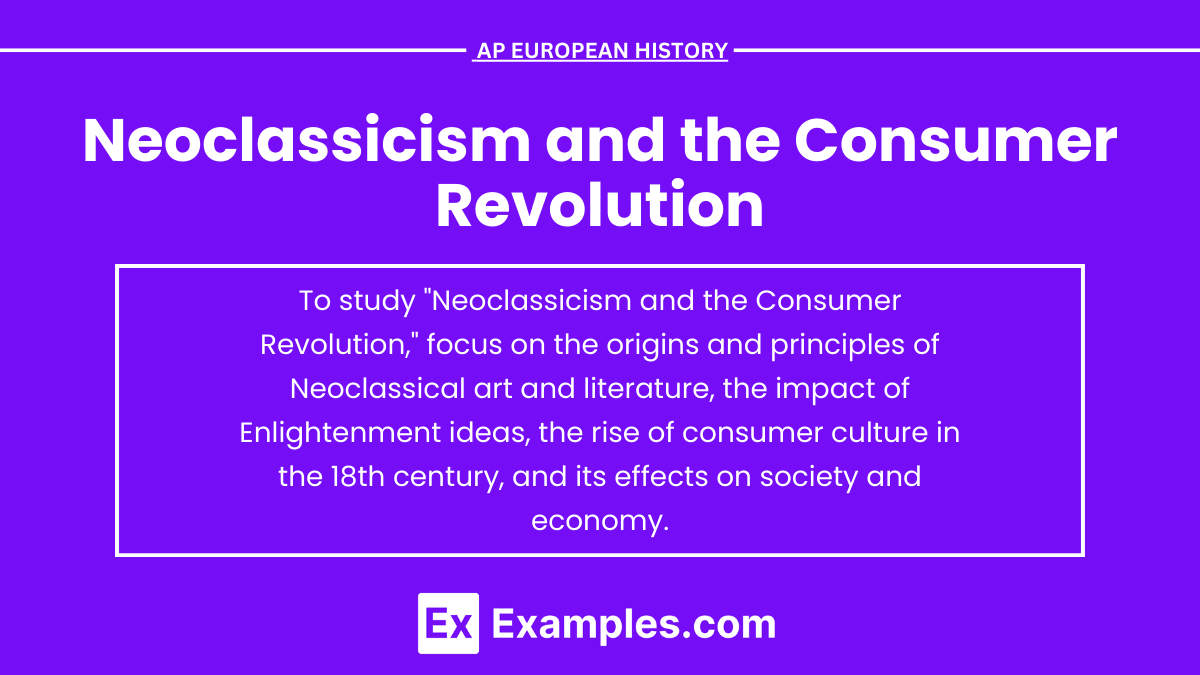The late 18th century in Europe witnessed the rise of Neoclassicism and the Consumer Revolution, two significant movements reflecting cultural and economic shifts. Neoclassicism, inspired by ancient Greek and Roman art, emphasized simplicity and moral virtue, contrasting the ornate Baroque style. Concurrently, the Consumer Revolution marked an increase in the availability and consumption of goods, driven by urbanization and new retail practices. These movements collectively highlighted a period of Enlightenment ideals, social change, and evolving cultural tastes in European society.
Learning Objectives
Understand the key characteristics of Neoclassicism in AP European History, including its classical themes and major artists like Jacques-Louis David and Antonio Canova. Grasp the concept of the Consumer Revolution, focusing on the expansion of goods, the rise of shopping culture, and social emulation. Analyze the connections between these movements and broader social and economic changes in 18th-century Europe, such as urbanization, changing social norms, and the impact of Enlightenment ideals on art and consumer culture.
Neoclassicism

Neoclassicism was an artistic and intellectual movement that drew inspiration from the “classical” art and culture of Ancient Greece and Rome. It emerged in the mid-18th century, partially as a response to the excesses of the Baroque and Rococo styles, which were seen as overly ornate and decadent. Neoclassicism emphasized clarity, order, and balance, mirroring the Enlightenment ideals of reason and rationality.
Characteristics
- Art and Architecture: Neoclassical art focused on simplicity, straight lines, and a restrained color palette. Key elements included columns, domes, and the use of symmetry. Notable architects like Robert Adam and Jacques-Germain Soufflot designed buildings such as the Panthéon in Paris, which embodied these ideals.
- Literature and Philosophy: Writers and philosophers such as Johann Joachim Winckelmann, Voltaire, and Denis Diderot promoted classical ideals. Winckelmann’s works, for example, emphasized the importance of Greek art and inspired the revival of classical principles in aesthetics.
- Sculpture and Painting: Neoclassical sculpture aimed to emulate the form and restraint of classical works, often depicting mythological subjects. Antonio Canova was a leading sculptor of this era. In painting, artists like Jacques-Louis David created works that emphasized moral seriousness and heroic themes, exemplified by David’s “Oath of the Horatii.”
- Music and Performing Arts: In Neoclassicism, music and performing arts emphasized clarity, structure, and formal discipline. Composers like Wolfgang Amadeus Mozart and Christoph Willibald Gluck focused on balanced compositions and expressive restraint, often inspired by ancient themes.
Neoclassicism reflected and influenced the broader cultural shift towards rationalism and Enlightenment thinking. It played a role in the political sphere as well, with figures like Napoleon Bonaparte using neoclassical imagery to project power and legitimacy. The movement also inspired civic architecture, emphasizing public buildings as symbols of civic virtue and democratic values.
The Consumer Revolution

The Consumer Revolution refers to the dramatic increase in the consumption and variety of goods by individuals from different social strata in the 18th century. This shift was driven by factors such as increased production capabilities, colonial expansion, and changing social attitudes towards consumption.
Key Aspects
- Expansion of Goods: The range of available goods expanded significantly, including textiles, tea, coffee, porcelain, and household items. This was facilitated by improvements in manufacturing and global trade networks, including the transatlantic trade.
- Social Changes: The Consumer Revolution led to changes in social behavior and identity. Consumption became a way for people to express their status and identity, leading to the emergence of new social norms around fashion and lifestyle. The rise of department stores and the proliferation of advertisements also played a role in shaping consumer culture.
- Economic Impact: The Consumer Revolution had a profound impact on the European economy. The demand for goods spurred innovation in production and distribution, leading to the growth of markets and the early stages of industrialization. It also contributed to the rise of a middle class that had disposable income and a desire for luxury goods.
The increased availability of goods allowed for greater social mobility and the formation of a consumer-oriented society. This period also saw the emergence of new financial instruments and credit systems, making it easier for people to purchase goods.
Interconnection between Neoclassicism and the Consumer Revolution

Though distinct, Neoclassicism and the Consumer Revolution were interconnected in several ways:
- Shared Cultural Context: Both movements were part of the broader Enlightenment period, which emphasized reason, progress, and the questioning of traditional authority. Neoclassicism’s appeal to rationality and classical virtues resonated with the burgeoning consumer culture’s emphasis on individuality and expression through consumption.
- Influence on Art and Design: The Consumer Revolution affected the production and distribution of neoclassical art and design. As demand for neoclassical styles grew, manufacturers produced more goods featuring classical motifs, making such items accessible to a wider audience.
- Political and Social Messaging: Neoclassical art often carried political and moral messages that aligned with the values of the Enlightenment and the emerging consumer society. For instance, the emphasis on civic duty and virtue in neoclassical art resonated with the aspirations of the middle class, who were increasingly influential in society.
Understanding the interplay between Neoclassicism and the Consumer Revolution provides insight into the cultural and economic transformations of 18th-century Europe. These movements not only shaped the arts and consumer behaviors of their time but also laid the groundwork for the modern world, influencing everything from political ideologies to everyday life.
Examples of Neoclassicism and the Consumer Revolution
- Architecture: Neoclassical buildings featured classical elements like columns and domes, reflecting the influence of ancient Greek and Roman designs.
- Fashion: Neoclassical fashion embraced simple, elegant lines and lightweight fabrics, inspired by Greco-Roman styles, contrasting with the ornate Rococo style.
- Furniture: Neoclassical furniture included classical motifs and fine woods, making stylish, affordable pieces accessible to a broader audience.
- Literature: Authors like Alexander Pope emphasized order and clarity, drawing inspiration from classical ideals, with their works widely read due to increased literacy.
- Art: Neoclassical paintings, often depicting heroic and patriotic themes, became popular among the growing middle class during the Consumer Revolution.
Practice Test Questions on Neoclassicism and the Consumer Revolution
Question 1: Which of the following characteristics is most associated with Neoclassicism in art and architecture?
A) Ornate decorations and elaborate designs
B) Emphasis on emotional expression and individualism
C) Simplicity, symmetry, and an emphasis on classical antiquity
D) Use of bold colors and dynamic compositions
Answer: C) Simplicity, symmetry, and an emphasis on classical antiquity
Explanation: Neoclassicism emerged in the mid-18th century as a reaction against the Rococo style, which was characterized by ornate decorations and elaborate designs. Neoclassicism drew inspiration from the classical art and culture of Ancient Greece and Rome. This movement emphasized simplicity, symmetry, and an adherence to classical ideals, reflecting a desire for a return to the perceived purity and rationality of the classical age. Neoclassical artists and architects favored clean lines and structured forms, often using motifs like columns, pediments, and classical figures in their work.
Question 2: What was a significant impact of the Consumer Revolution in the 18th century?
A) Decrease in the variety of goods available to the public
B) Increased emphasis on luxury goods and conspicuous consumption
C) A shift away from individual craftsmanship towards mass production
D) Decline in the importance of advertising and marketing
Answer: B) Increased emphasis on luxury goods and conspicuous consumption
Explanation: The Consumer Revolution in the 18th century marked a significant shift in the way goods were produced and consumed. It was characterized by an increase in the availability and variety of goods, as well as a rise in disposable income among the middle and upper classes. This period saw a growing emphasis on luxury goods and conspicuous consumption, where people purchased items not only for their practical use but also to display wealth and social status. The Consumer Revolution also saw advancements in advertising and marketing, which helped stimulate demand and create new consumer desires.
Question 3: How did the ideals of Neoclassicism influence the Consumer Revolution?
A) Encouraged mass production of inexpensive, everyday items
B) Promoted the purchase of ornate and highly decorative goods
C) Inspired a taste for classical styles in luxury goods and fashion
D) Led to a decline in the popularity of classical architecture
Answer: C) Inspired a taste for classical styles in luxury goods and fashion
Explanation: Neoclassicism had a significant influence on the Consumer Revolution, particularly in the realms of luxury goods and fashion. The Neoclassical emphasis on classical antiquity inspired a taste for classical styles, which became fashionable in various aspects of consumer culture. This influence could be seen in furniture, clothing, ceramics, and other decorative arts, where classical motifs such as Greek and Roman designs became popular. Neoclassicism’s focus on simplicity and elegance also appealed to the tastes of the growing middle and upper classes, who sought to display their cultural refinement through the consumption of such goods.


